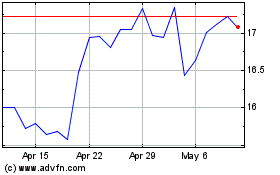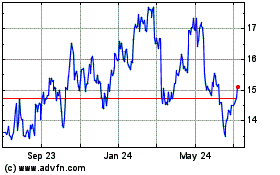By Ira Iosebashvili
Some traders anticipating a rebound in oil are making an
indirect bet: wagering on energy companies and the currencies of
oil-producing nations instead of the commodity itself.
Their approach is spurred in part by contango, an occasional
event in which the current price of oil is lower than prices for
future delivery. The phenomenon, which prevailed this year, makes
it more expensive to bet on oil futures, as it forces investors pay
up when they trade out of old contracts and into newer ones.
To avoid pricey futures, traders have turned to other wagers as
a proxy for oil. Some of the trades are looking smart compared with
a pure oil bet: The krone, the currency of major oil producer
Norway, has fallen just 2.8% since the start of November, a period
in which Brent futures dropped 27% to an 11-year low. The dollar
bonds of Brazilian oil giant Petróleo Brasileiro SA have fallen 10%
over the same span.
Simply betting on the price of a commodity "is not a thing
anymore," said Michael Hague, global head of commodities research
at Société Générale in New York. "These days it's more about going
long and short, using more exotic investments."
U.S. oil prices surpassed prices on the global market for the
first time in four years on Tuesday, adding one more twist in an
already topsy-turvy energy market. Light, sweet crude for February
delivery gained 33 cents, or 0.9%, to $36.14 a barrel on the New
York Mercantile Exchange. Brent, the global benchmark, fell 24
cents, or 0.7%, to $36.11 a barrel on ICE Futures Europe, setting a
new low dating back to July 2004.
Contango isn't the only factor driving these proxy trades. Many
investors believe that oil producers' currencies and energy-firm
securities are due to bounce back. Others want to avoid the hefty
losses that have scarred raw-materials markets this year.
Some are seeking to boost returns, for instance by purchasing
interest-bearing assets such as the Petrobras bonds or by pairing a
bet on oil-related investments with a bet against something
else.
Money managers say using these roundabout approaches can
mitigate losses and cut volatility. Mr. Hague is recommending
clients play a potential bounce in beaten-down crude prices by
investing in a basket made up of oil-sensitive currencies such as
the Russian ruble, Norwegian krone, Mexican peso and Canadian
dollar. While all are down, none matches the 32% loss in U.S. oil
prices this year.
Many traders warn that proxy bets carry their own risks. The
strategy can increase the chances of making a bad call, and could
magnify losses if markets turn treacherous and correlations--a
measure of how much various asset prices move together--break
down.
"It's hard enough to be right on one thing, and now, you have to
be right on at least two," said Tobias Moskowitz, a professor at
the University of Chicago Booth School of Finance.
An investor betting on a currency as a way to play an oil price
rebound, for example, must account for a whole slew of additional
factors not strictly related to oil, such as central-bank policy
and the strength of the U.S. dollar. An energy company's securities
may be hurt by dozens of idiosyncratic, company-specific factors or
a broader selloff in stocks, and could decline even if oil prices
rise. Bond investors must carefully gauge interest-rate movements
and a company's creditworthiness.
At the same time, correlations that had been in place for months
can go awry at inopportune times, Mr. Moskowitz said.
"We build models based on long-term relationships, but during
times of extreme market stress they can change dramatically, and
usually not in your favor," he said.
Money managers say risks of using oil proxies often are
justified by avoiding the high cost of betting on futures.
Investors buying dollar-denominated foreign bonds have been
rewarded in recent years, as a rising U.S. currency helped bolster
returns over debt issued in the local currency. Some investors
believe that Norway can use its $850 billion sovereign-wealth fund
to stave off any oil-related hits to its economy, which they say
has helped the krone outperform crude prices in the past two
months. Petrobras's bonds may have been spared from bigger losses
because some investors believe that Brazil won't allow the company
to go under, even if oil prices fall further.
Meanwhile, many crude proxies already have notched big declines,
suggesting a limit to future downside moves, they say. The Mexican
peso, for instance, is down more than 32% since May 2011. Petrobras
bonds have fallen by about 23% since December 2014.
Wasif Latif, who helps manage about $27 billion at USAA
Investments, is buying the stocks of oil producers such as
ConocoPhillips and Cimarex Energy Co., which have been hurt during
the decline in crude prices. Cimarex's shares have fallen nearly
20% this year. ConocoPhillips's stock price is off by 33%.
"Oil can go down further, and trading in these stocks may still
be choppy," Mr. Latif said. "But from a valuation perspective they
are very attractive."
(END) Dow Jones Newswires
December 22, 2015 19:05 ET (00:05 GMT)
Copyright (c) 2015 Dow Jones & Company, Inc.
Petroleo Brasileiro ADR (NYSE:PBR)
Historical Stock Chart
From Mar 2024 to Apr 2024

Petroleo Brasileiro ADR (NYSE:PBR)
Historical Stock Chart
From Apr 2023 to Apr 2024
